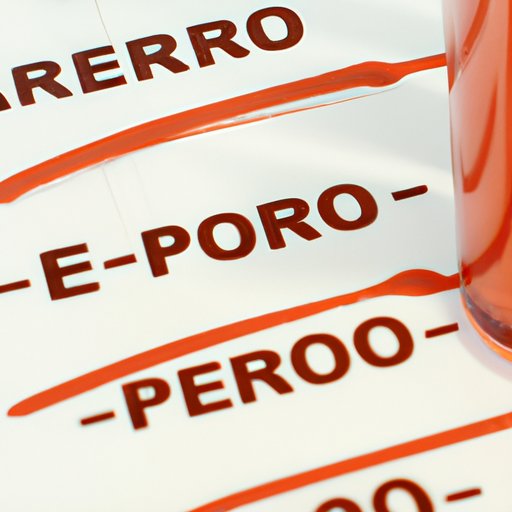
Introduction
When it comes to scientific calculations, understanding how to calculate percent error for density is essential. It is a measure of how far away your results are from the true value and is useful in assessing the accuracy of your experimental measurements. In this article, we will explain the basics of percent error for density, how to calculate it, common mistakes to avoid, and its applications in various fields.
Basic Definitions and Formulas
Density refers to the ratio of mass to volume of a substance. It is measured in grams per cubic centimeter (g/cm³) in the metric system. Percent error is the difference between the measured and true values expressed as a percentage. The formula for calculating percent error for density is as follows:
:max_bytes(150000):strip_icc():format(webp)/percent-error-density-606415-lessons-56a89cca3df78cf7729ed889.png)
For example, if your experimental density is 2.5 g/cm³, and the actual value is 2.65 g/cm³, you can use the formula to calculate the percent error.
Step-by-Step Guide to Calculating Percent Error for Density
To determine the percent error for density, you can follow these simple steps:
Gathering the data
To start the calculation, you need to collect the necessary data. This includes the experimental value for density, which you obtain by measuring the mass and volume of the sample.
Calculating the experimental density
To calculate the experimental density, divide the mass by the volume of the sample. For example, if the mass of the sample is 25 grams, and the volume is 10 cm³, the experimental density would be:
Experimental density = Mass ÷ Volume
Experimental density = 25 g ÷ 10 cm³
Experimental density = 2.5 g/cm³
Calculating the actual/theoretical density
The actual density refers to the accepted value of density, while the theoretical density is the density expected based on a prediction. To calculate the percent error, you should use the actual density unless a theoretical value is given. You can find the actual density by researching and consulting reliable sources or using a reference text.
Applying the percent error formula
Once you obtain both the experimental and actual densities, plug them into the formula. Subtract the actual value from the experimental value, take the absolute value of the difference, divide it by the actual density, and multiply by 100 to express it as a percentage.
Percent error for density = | (Experimental value – Actual value) ÷ Actual value | × 100
Using the data from the example above:
Percent error for density = |(2.5 g/cm³ – 2.65 g/cm³) ÷ 2.65 g/cm³| × 100
Percent error for density = 5.66%
Analyzing Common Mistakes
One common mistake when calculating percent error for density is using the wrong formula. Ensure that you use the formula for density, which divides mass by volume, instead of the formula for other properties. Another mistake is failing to take the absolute value of the difference between the experimental and actual values. Lastly, many people forget to multiply the result by 100 to express it as a percentage.
Some tips to avoid these mistakes include double-checking the formula and ensuring you use the correct units of measurement, using the absolute value function to prevent errors in negative values, and multiplying by 100 to express the result as a percentage.
Showcasing Real-World Applications
Percent error for density is relevant in many fields, including chemistry, physics, biology, and materials science. For example, in the chemical industry, manufacturers use percent error for density to ensure their products meet required specifications. In physics, density measurements help determine the composition of stars and planets. In biology, researchers use density measurements to analyze and separate different cell types.
Comparing Different Calculations
There are several methods for calculating percent error for density, including percent difference and relative percent difference. Percent difference involves taking the difference between the experimental and actual value, dividing it by the average value of the two, and multiplying by 100. On the other hand, relative percent difference (RPD) is the percent difference divided by the actual value and multiplied by 100. While percent difference is more straightforward, relative percent difference is useful when the values of the two samples being compared differ significantly.
Answering Frequently Asked Questions
What is considered an acceptable percent error for density?
There is no fixed number for acceptable percent error. However, a percent error less than 5% is generally considered acceptable in most fields.
How is density determined experimentally?
To determine the density experimentally, measure the mass and volume of the sample and divide the mass by the volume. The mass can be measured using a balance, while the volume can be measured using various methods such as displacement, pouring it into a graduated cylinder, and measuring the volume of the irregularly shaped object using the water displacement method.
Why is percent error for density essential?
Percent error for density is essential because it helps you evaluate the accuracy and precision of your measurements. Without it, you may not know whether your measurements are valid and reliable.
Conclusion
Calculating percent error for density is an important skill in scientific calculations. It helps ensure the accuracy of your measurements and enables you to improve the quality of your results. By following the simple steps we outlined in this article, you can calculate percent error for density easily. Practice is essential to gain mastery of the concepts and techniques. Learning how to calculate percent error for density is a significant step towards achieving accuracy in your experimental work.





